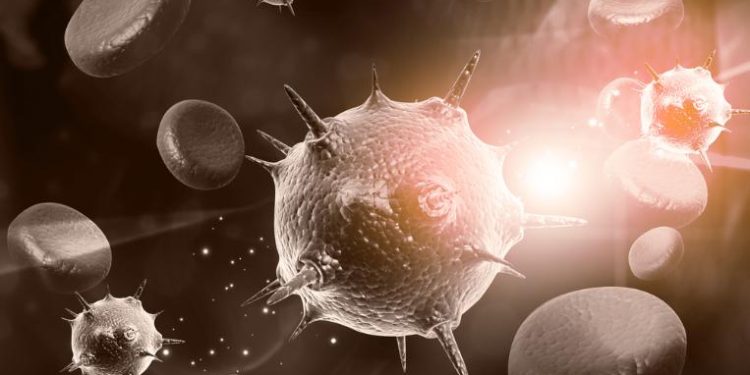A lung cancer diagnosis usually involves a biopsy. Your provider might use a thin tube (bronchoscope) to look inside your airways for tumors and take samples to biopsy.
When a clinician “stages” cancer, they determine its size and how far it has spread from where it began. For small cell lung cancer, your doctor might describe it as limited or extensive stage.
Chemotherapy
Small cell lung cancer often spreads to other parts of the body. Chemotherapy uses drugs to kill cancer cells and stop them from growing. It can be used alone or with radiation therapy and immunotherapy.
Your healthcare team will decide the best treatment for you based on your stage of cancer and other factors. You may want to think about taking part in a clinical trial. These studies test new ways to prevent, find and treat cancer.
Smoking is the main cause of all types of lung cancer. Second-hand smoke and exposure to asbestos and radon also increase your risk of getting lung cancer. The two main types of small cell lung cancer are small cell carcinoma and combined small cell carcinoma. Both are less common than non-small cell lung cancer.
Lung cancer cells look flat like oats under a microscope. They grow and spread quickly, so you need to start treatment right away. The first step is a biopsy to check if you have cancer. Your healthcare provider will order imaging tests to find out the size of the tumor and where it is located in your lungs. They will also look at your lymph nodes in the chest and around the lungs to see if there is any cancer there.
You will have surgery if the cancer is limited stage, which means it’s in 1 lung or in a smaller area of your lung. Your healthcare providers may remove a part of the lung where the cancer is located (lobectomy) or they may remove your entire lung (segmental resection). You will have chemotherapy after surgery to kill any lingering cancer cells.
If your cancer is in the extensive stage, it has spread to other parts of your lungs and to nearby lymph nodes. It may have also spread to other organs in your body, such as your brain and bones. Chemotherapy and radiation are the main treatments for this stage of cancer.
Immunotherapy uses substances made by your body or made in a lab to boost, direct or restore your immune system’s natural ability to fight cancer. Your healthcare provider will prescribe drugs called PD-1 and PD-L1 inhibitors to help your immune system kill cancer cells. These medicines are given by mouth or through an IV. They are named after the proteins PD-1 and PD-L1 on cancer cells. Examples of PD-L1 inhibitors are atezolizumab and durvalumab.
Immunotherapy
The immune system is the body’s natural defense against cancer. It recognizes and destroys cancer cells that have mutations that allow them to grow out of control. But some cancer cells have ways to hide from the immune system or trick it into not recognizing them. Immunotherapy can help the immune system find and kill cancer cells.
The type of immunotherapy you get depends on the stage of your cancer and other factors. We have several clinical trials that are exploring new approaches to treating small cell lung cancer.
Chemotherapy uses drugs to kill cancer cells or stop them from growing. It can be taken by mouth or injected into a vein or muscle. When chemotherapy is given by mouth, it enters the bloodstream and can reach cancer cells throughout the body (systemic chemotherapy). When chemotherapy is injected directly into an organ or a body cavity such as the abdomen, it reaches cancer cells in specific areas (regional chemotherapy).
We have seen promising results with immunotherapy in limited-stage small cell lung cancer. Nivolumab, pembrolizumab and durvalumab have all shown improved survival compared to cytotoxic chemotherapy alone. In addition, the PD 1 inhibitor lurbinectedin shows promising efficacy in combination with nivolumab in treatment nave extensive small cell lung cancer.
Our research is also focusing on immunotherapy for metastatic small cell lung cancer. Metastasis is when cancer cells break away from the primary tumor in the lungs and travel to other parts of the body, such as the brain. We are evaluating a combination of chemotherapy and lurbinectedin in combination with durvalumab, which has shown promising response rates.
It’s important to talk with your health care team about the side effects you have during and after immunotherapy. Tell them if any of the side effects seem to get worse or last longer than usual, so they can suggest ways to make you feel better. They will be able to give you information about where to get more details on your specific drug’s side effects.
Surgery
Small cell lung cancer (SCLC) usually develops in the lungs and can spread to other parts of the body. It may cause symptoms such as coughing up blood (haemoptysis) or difficulty breathing (dyspnoea). SCLC is one of a group of cancers called neuroendocrine carcinomas, and it occurs mostly in current or former smokers. It can be hard to diagnose because it often doesn’t cause any symptoms at first. It can be diagnosed using laboratory tests such as a fine needle biopsy, bronchoscopy or CT scan. Surgical biopsy is also used to confirm the diagnosis. During this test, healthcare providers look inside your airways with a thin tube-like instrument called a bronchoscope and remove tissue for testing. This type of biopsy is done to check for a cancerous tumour and to help decide how much treatment you need.
If you have limited stage small cell lung cancer, it’s possible to cure it with surgery and radiation. Your health care team will decide whether you need a lobectomy or segmental resection, which are types of surgery that remove part of the lung. They’ll also remove lymph nodes in your chest and around your lungs to see if they contain cancer.
Radiation therapy uses high-dose X-rays to destroy cancer cells. You might have external radiation, which is given from a machine outside your body or internal radiation, which involves injecting a solution into the lungs that contains radiation. You might also have endobronchial therapies, which are ways to treat the airways in your lungs by using special tubes with a lighted scope (endoscope) that can open a blockage caused by cancer or by another disease.
You might want to think about taking part in a clinical trial, which is an experiment to find new ways to prevent, detect or treat disease. You can ask your healthcare provider about clinical trials available in your area.
Radiation
Radiation therapy uses high-energy x-rays or other types of radiation to kill cancer cells or keep them from growing. It can be used as a treatment by itself or with chemotherapy. It may be given in a hospital or clinic, or it may be given at home. Radiation is often called ionizing radiation because it can knock electrons off of atoms, which changes them from neutral to charged particles, called ions. Living cells are made up of trillions of atoms, so even a small amount of ionizing radiation can damage them and lead to cancer.
Lung cancer starts in the cells that line the lungs. It can grow quickly and spread to other parts of the body. The cancer can be cured if it is caught early. The stages of lung cancer are based on where the cancer is when it is found and how far it has spread.
If a person is diagnosed with limited stage small cell lung cancer, the doctors can usually cure it with surgery and radiation. It is very important to quit smoking and avoid second-hand smoke. Other risk factors for cancer include exposure to asbestos, radon and certain medicines.
Extensive stage small cell lung cancer is more difficult to treat. The cancer has spread beyond the lungs to other parts of the body, such as the lymph nodes and other organs. Doctors can sometimes treat this type of cancer with drugs that help the immune system fight the cancer and with other medicines.
Some people with advanced small cell lung cancer have a better chance of survival if they are treated with immunotherapy and other treatments that aim to help the immune system fight the disease. These treatments are being studied in clinical trials.
If the cancer has spread to the brain, doctors may give prophylactic cranial irradiation (PCI) before other treatments. This is done to reduce the chance of the cancer spreading to the brain. This is a new treatment option that may improve survival for some people with this type of cancer. It is not yet available everywhere.









